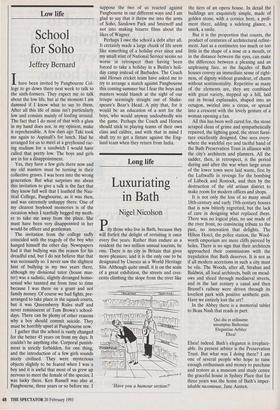Long life
Luxuriating in Bath
Nigel Nicolson
Pity those who live in Bath, because they will forfeit the delight of revisiting it once every five years. Rather than endure as a resident the two million annual tourists, be one. There is no city in Britain that gives more pleasure, and it is the only one to be designated by Unesco as a World Heritage Site. Although quite small, it is on the scale of a great exhibition, the streets and cres- cents climbing the slope from the river like Have you a humour section?' the tiers of an opera house. In detail the buildings are exquisitely simple, made of golden stone, with a cornice here, a pedi- ment there, adding a sidelong glance, a smirk, a smile.
But it is the proportion that counts, the product of centuries of architectural refine- ment. Just as a centimetre too much or too little in the shape of a nose or a mouth, or in the distance between the eyes, can make the difference between a pleasing and an unpleasing face, so the façades of Bath houses convey an immediate sense of right- ness, of dignity without grandeur, of charm without sentimentality. Repetitive as many of the elements are, they are combined with great variety, stepped up a hill, laid out in broad esplanades, shaped into an octagon, swirled into a circus, or spread into a crescent with the lovely gesture of a woman opening a fan.
All this has been well cared for, the stone scraped clean of grime and sympathetically repaired, the lighting good, the street furni- ture excellently designed. One sees every- where the watchful eye and tactful hand of the Bath Preservation Trust in alliance with the city's architects and planners. All the sadder, then, in retrospect, is the period during and after the war when large areas of the lower town were laid waste, first by the Luftwaffe in revenge for the bombing of Liibeck and Rostock, and then by the destruction of the old artisan district to make room for modern offices and shops.
It is not only the loss of so many small 18th-century and early 19th-century houses that is now bitterly regretted, but the lack of care in designing what replaced them. There was no logical plan, no use made of the river front, no convincing tribute to the past, no innovation that delights. The Hilton Hotel, the police station, the Wool- worth emporium are mere cliffs pierced by holes. There is no sign that their architects approached their commissions with the trepidation that Bath deserves. It is not as if all modern accretions in such a city must be vile. The Woods, after all, Strahan and Baldwin, all local architects, built on mead- ows and sliced through mediaeval streets, and in the last century a canal and then Brunel's railway were driven through its loveliest park with positive aesthetic gain. Have we entirely lost the art?
In the Abbey there is a memorial tablet to Beau Nash that reads in part:
Qui diu et utilissime assumptus Bathoniac Elegantiae Arbiter Eheu!
Eheu! indeed. Bath's elegance is irreplace- able. Its present arbiter is the Preservation Trust. But what was I doing there? I am one of several people who hope to raise enough enthusiasm and money to purchase and restore as a museum and study centre the graceful house in Sydney Place that for three years was the home of Bath's imper- ishable raconteuse, Jane Austen.


























































 Previous page
Previous page